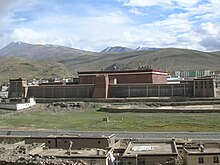Sakya Monastery
| Sakya Monastery | |
|---|---|

Sakya Monastery
|
|
| Tibetan transcription(s) | |
| Tibetan | ས་སྐྱ་དགོན། |
| Wylie transliteration | s dPal Sa skya |
|
|
|
| Coordinates | 28°54′18″N 88°1′4.8″E / 28.90500°N 88.018000°E |
| Monastery information | |
| Location | Shigatse Prefecture, Tibet |
| Founded by | Konchok Gyelpo |
| Founded | 1073 |
| Type | Tibetan Buddhist |
| Sect | Sakya |
| Lineage | Sakya |
| Head Lama | Sakya Trizin |
| Architecture | Mongolian architecture |
Sakya Monastery (Tibetan: ས་སྐྱ་དགོན་པ།, Wylie: sa skya dgon pa), also known as Pel Sakya (Tibetan: དཔལ་ས་སྐྱ།, Wylie: dpal sa skya; "White Earth" or "Pale Earth") is a Buddhist monastery situated 25 km southeast of a bridge which is about 127 km west of Shigatse on the road to Tingri in Tibet.
As the seat of the Sakya (or Sakyapa) school of Tibetan Buddhism, it was founded in 1073, by Konchok Gyelpo (Tibetan: དཀོན་མཆོག་རྒྱལ་པོ།, Wylie: dkon mchog rgyal po; 1034–1102), originally a Nyingmapa monk of the powerful noble family of the Tsang and became the first Sakya Trizin. Its powerful abbots governed Tibet during the 13th and the 14th centuries under the overlordship of the Mongol Yuan dynasty after the downfall of the Tibetan Empire until they were eclipsed by the rise of the new Kagyu and Gelug schools of Tibetan Buddhism.
...
Wikipedia

